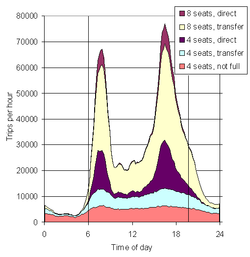Cost-benefit assessment on composite traffic in Helsinki
| Moderator:Jouni (see all) |
|
|
| Upload data
|
Cost-benefit assessment on composite traffic in the Helsinki metropolitan area evaluates operational costs, health costs, and carbon dioxide climate costs in a hypothetical situation where a part of private car traffic is replaced by composite traffic in 2005. The assessment work was closed in 2005, but the description was written afterwards.
| Main message: |
|---|
| Question:
What are the operational costs, health costs, and carbon dioxide climate costs in a hypothetical situation where a part of private car traffic is replaced by composite traffic in 2005? The part that is replaced varies from 0 to 100 %.
|
Scope
Purpose
What are the operational costs, health costs, and carbon dioxide climate costs in a hypothetical situation where a part of private car traffic is replaced by composite traffic in 2005? The part that is replaced varies from 0 to 100 %.
Boundaries
- Temporal: One typical working day in 2005.
- Spatial: Helsinki metropolitan area
- Impacts:
- Capital and operational costs
- Health costs due to mortality caused by fine particle emissions.
- Climate costs due to carbon dioxide emissions.
Scenarios
- The fraction of composite trips of all trips varies from 0 to 100 %.
- Composite traffic does not have interactions with the demand of public transport.
Indended users
- City-level decision-makers in Helsinki, the neighbouring municipalities, and elsewhere.
- Helsinki Metropolitan Area Council
- The Ministry of Transport
Participants
- Jouni Tuomisto, Marko Tainio from THL
Definition
Decision variables
- Passenger level: whether to choose a private car or composite traffic (the decision by a random passenger)
- Societal level: the target fraction of composite traffic from all trips that used to be private car trips. The amount of subsidies needed for composite traffic to reach the target is estimated based on costs to a passenger.
Indicators
Other variables
- Trip rate on a workday in the Helsinki metropolitan area
- Route matrix in the Helsinki metropolitan area
- Car kilometres driven in the Helsinki metropolitan area
- Aggregated trip rate on a workday in the Helsinki metropolitan area
- Traffic impact indicators in the Helsinki metropolitan area
Indices
- Hma_area (used as both origin and destination)
- Hma_zone
- Period_1
- Output_1
- Vehicle_1
- Length_1
- Comp_fr
Analyses
VOI and importance analysis
VOI for a passenger
- Endpoint: Costs to a random passenger.
- Decision-maker: A random passenger.
- Decision: Choose private car or composite traffic for a trip.
- Variables for which VOI is calculated: All. In addition, total VOI.
VOI for the society
- Endpoint: Costs to the society, including subsidies needed.
- Decision-maker: The society (a municipal authority that can decide about the Helsinki metropolitan area public transport and subsidies. In practice, this could be Helsinki Metropolitan Area Council.
- Decision: Choose the target level for composite traffic (and pay for the consequent subsidies that are needed to hit the target).
- Variables for which VOI is calculated: All. In addition, total VOI.[1]
Result
Results
The results are publised as a scientific article[1]
 |
 |
 |
Conclusions
- 45-60% composite fraction is optimal
- Composite traffic reduces pressures typically by 50-70%
- Composite traffic is more attractive to those with long (>= 5 km) trips
- Total societal VOI is 30000 euro/d, which implies robust conclusions
See also
- Cost-benefit analysis on composite traffic in the Helsinki Metropolitan area (an updated assessment)
- Opasnet:Composite traffic in theoretical Europe (research)
- Theoretical grid and road network for Europe